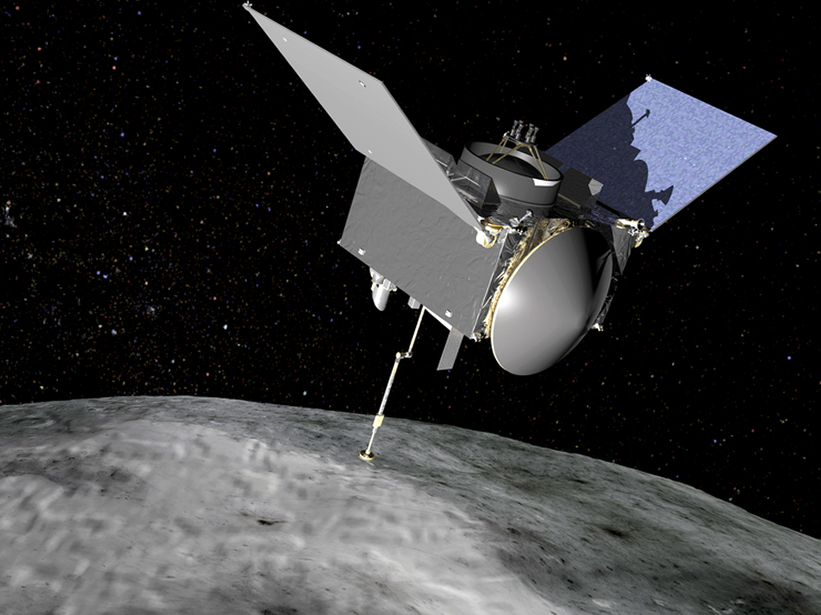Bennu, a carbon-rich asteroid orbiting close to Earth, will get a close-up visitor in the next decade. On 8 September, NASA’s new Origins-Spectral Interpretation-Resource Identification-Security-Regolith Explorer (known as OSIRIS-REx) will launch, beeline to the asteroid, collect samples, and bring them back to Earth.
“We are well equipped to investigate Bennu and return with our scientific treasure.”
“The launch of OSIRIS-REx is the beginning of a 7-year journey to return pristine samples from asteroid Bennu,” said Dante Lauretta, OSIRIS-REx principal investigator. “The team has built an amazing spacecraft, and we are well equipped to investigate Bennu and return with our scientific treasure.”
The spacecraft, armed with imaging equipment, a robotic arm, and a parachuted return payload, will arrive at Bennu in 2 years, where it will study the asteroid from afar before homing in to collect samples from the surface. Another 5 years after that, its precious payload will arrive back on Earth, giving scientists a rare peek at one of the solar system’s more than 150 million asteroids.
Why an Asteroid?
Around 4.5 billion years ago, our infant solar system began to coalesce into larger chunks from a massive cloud of gas and dust. This process would eventually form our solar system’s planets, dwarf planets, asteroids, and comets. Asteroids, those airless, rocky objects that are too small to be planets, are some of the most primitive objects remaining.
“[Bennu] will enable us to learn about our initial collapsing cloud because it’s such a primitive body,” said Jim Green, the director of NASA’s Planetary Science Division.
Additionally, scientists hope to learn about the kinds of materials that asteroids could have brought to Earth during the early days of the solar system, Lauretta said. During these early days, the planet was pummeled by asteroids during what’s known as the Late Heavy Bombardment. Carbon-rich asteroids like Bennu could have brought organic molecules or amino acids to Earth—these could have been the precursors for life on our planet, explained Christina Richey, OSIRIS-REx’s deputy program scientist.
Why Bennu?
NASA targeted Bennu for several reasons, including its relatively easy accessibility, its size, and its composition, Richey said. Bennu orbits the Sun relatively close to Earth, at varying distances between 0.8 and 1.6 astronomical units (AU) away—for comparison, Earth is 1 AU away from the Sun. Bennu also has an orbital inclination similar to Earth’s. This close proximity and similar inclination make Bennu an ideal candidate for a probe programmed to return samples, Richey explained.
Asteroids like Bennu are rare, so sampling it gives scientists a chance at finding organic molecules that could be precursors for life.
Asteroids smaller than 200 meters across—that’s half a lap around an Olympic track—rotate too quickly for a spacecraft to map. Bennu measures approximately 492 meters in diameter and rotates once every 4.3 hours, which also makes it a good candidate for investigation, Richey added.
Finally, Bennu’s primitive, carbon-rich composition will give scientists the window they seek into conditions in the solar system 4.5 billion years ago. Asteroids like Bennu are rare so close to the Sun, so sampling it gives scientists a chance at finding organic molecules that could be precursors for life, Richey said.
The Gentle High Five
The OSIRIS-REx spacecraft employs a sample return capsule—complete with parachute—almost identical to the capsule used in NASA’s Stardust mission that returned samples of a comet’s tail in 2006. The new spacecraft also contains instruments to analyze the topography, chemical composition, and minerology of Bennu’s surface.
The spacecraft will also include a device called the Touch-and-Go Sample Acquisition Mechanism, a 3.35-meter-long robotic arm tipped with a circular sample collection instrument. The device will briefly touch down on the surface of Bennu, giving it a “gentle high five,” said Rich Kuhns, OSIRIS-REx program manager.
A pogo mechanism in the robot arm will hold the sample head in place for the 3–5 seconds it needs to blast the surface with nitrogen gas, dislodging material for collection. There’s enough nitrogen on board for three attempts—if all goes as planned, scientists estimate that OSIRIS-REx could collect up to 2 kilograms of asteroid material in July 2020.
Then, in September 2023, OSIRIS-REx will return to Earth’s neighborhood, where it will jettison its payload to Earth.
“A return sample is really the big prize,” said Jeffrey Grossman, OSIRIS-REx program scientist.
—JoAnna Wendel, Staff Writer
Citation:
Wendel, J. (2016), NASA’s new asteroid sampler will illuminate solar system’s history, Eos, 97, https://doi.org/10.1029/2016EO057863. Published on 19 August 2016.
Text © 2016. The authors. CC BY-NC-ND 3.0
Except where otherwise noted, images are subject to copyright. Any reuse without express permission from the copyright owner is prohibited.

